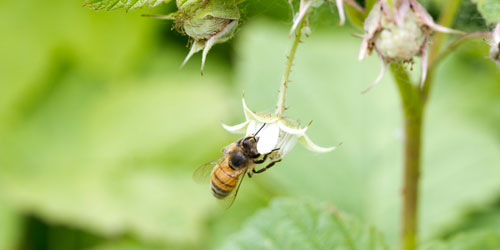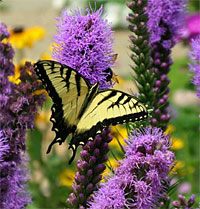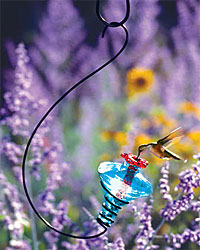





As a founding employee of Gardener's Supply, I wore many different hats over the years. Currently, I have my own company called Johnnie Brook Creative. The gardens around my home in Richmond, VT, include a large vegetable garden, seasonal greenhouse, cutting garden, perennial gardens, rock garden, shade garden, berry plantings, lots of container plants and a meadow garden. There's no place I'd rather be than in the garden.

A honeybee pollinates a raspberry flower.

Liatris is one of the many perennials that attracts butterflies. For more butterfly-attracting perennials, see the chart at the end of this article.
The most important step you can take is to plant a pollinator-friendly garden. Choose nectar and pollen-rich plants like wildflowers and old-fashioned varieties of flowers. A succession of blooming annuals, perennials and shrubs is best so nectar and pollen will be available throughout the growing season. Also, include plants like dill, fennel and milkweed that butterfly larvae feed on.
Any size garden can attract and support pollinators — from a wildflower meadow to a planter with a few well-chosen species. Researchers in Tuscon, AZ, have found that communities of bees can sustain themselves for long periods of time in small vacant city lots.
A patchwork of pollinator gardens in neighborhoods, cities and rural areas around the country could provide enough habitat to restore healthy communities of beneficial insects and pollinators.
Many pesticides — even organic ones — are toxic to bees and other beneficial organisms. There's no need to use powerful poisons to protect your garden from insects and diseases. In the short term they may provide a quick knock-down to the attackers, but they also kill beneficial organisms. In the long term, you expose yourself, family, pets and wildlife to toxic chemicals, and risk disrupting the natural ecosystem that you and your garden inhabit.
An organic approach is both safer and more effective. By applying the simple principles of ecological plant protection, you can work with nature to control pests and diseases, enjoy a healthier garden and harvest and protect pollinators and other beneficial insects.
If you do apply pesticides make sure you apply them carefully and selectively. To protect pollinators, do not use pesticides on open blossoms or when bees or other pollinators are present.

A Hummingbird Feeder becomes a living work of art when hummingbirds dart back and forth to feed.
Butterflies, bees and other pollinators need shelter to hide from predators, get out of the elements and rear their young. Let a hedgerow or part of your lawn grow wild for ground-nesting bees. Let a pile of grass cuttings or a log decompose in a sunny place on the ground. Or, allow a dead tree to stand to create nooks for butterflies and solitary bees.
Artificial nesting boxes can also help increase the population of pollinators in your area. Wooden blocks with the proper-sized holes drilled into them will attract mason bees. Bat boxes provide a place for bats to raise their young.
A pollinator garden will provide pollen and nectar. Consider adding special feeders to help attract hummingbirds and butterflies.
Bees, birds and butterflies also all need water. Install a water garden, a birdbath or a catch basin for rain. Butterflies are attracted to muddy puddles which they will flock to for salts and nutrients as well as water.
You don't have to live in the country to keep bees. All you need is a little space, a water source, plenty of nearby flowers for them to visit, and a willingness to learn. Keeping a beehive or two in the backyard used to be a common practice. Maybe it's time to bring back this old-fashioned hobby. It does require equipment and some specific knowledge. But it's nothing an interested hobbyist can't handle. For more information, read Attracting Beneficial Bees.
Removing Those Stubborn Garden Weeds And Other Great Gardening Tips
Know More About Garden Or Patio Furniture And Other Teak Furniture
Butterfly Garden Feeding: How To Feed And Water Butterflies In Gardens
Flame Acanthus Attracts Butterflies and Hummingbirds All Summer Long
Help Monarchs and Other Butterflies by Planting Common Milkweed
Copyright © www.100flowers.win Botanic Garden All Rights Reserved